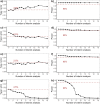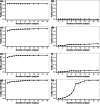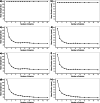Bayesian adaptive design for pediatric clinical trials incorporating a community of prior beliefs
- PMID: 35448963
- PMCID: PMC9027907
- DOI: 10.1186/s12874-022-01569-x
Bayesian adaptive design for pediatric clinical trials incorporating a community of prior beliefs
Abstract
Background: Pediatric population presents several barriers for clinical trial design and analysis, including ethical constraints on the sample size and slow accrual rate. Bayesian adaptive design methods could be considered to address these challenges in pediatric clinical trials.
Methods: We developed an innovative Bayesian adaptive design method and demonstrated the approach as a re-design of a published phase III pediatric trial. The innovative design used early success criteria based on skeptical prior and early futility criteria based on enthusiastic prior extrapolated from a historical adult trial, and the early and late stopping boundaries were calibrated to ensure a one-sided type I error of 2.5%. We also constructed several alternative designs which incorporated only one type of prior belief and the same stopping boundaries. To identify a preferred design, we compared operating characteristics including power, expected trial size and trial duration for all the candidate adaptive designs via simulation when performing an increasing number of equally spaced interim analyses.
Results: When performing an increasing number of equally spaced interim analyses, the innovative Bayesian adaptive trial design incorporating both skeptical and enthusiastic priors at both interim and final analyses outperforms alternative designs which only consider one type of prior belief, because it allows more reduction in sample size and trial duration while still offering good trial design properties including controlled type I error rate and sufficient power.
Conclusions: Designing a Bayesian adaptive pediatric trial with both skeptical and enthusiastic priors can be an efficient and robust approach for early trial stopping, thus potentially saving time and money for trial conduction.
Keywords: Bayesian adaptive design; Interim analysis; Pediatric clinical trials; Prior belief.
© 2022. The Author(s).
Conflict of interest statement
The authors declare that they have no competing interests.
Figures







Similar articles
-
Do we need to adjust for interim analyses in a Bayesian adaptive trial design?BMC Med Res Methodol. 2020 Jun 10;20(1):150. doi: 10.1186/s12874-020-01042-7. BMC Med Res Methodol. 2020. PMID: 32522284 Free PMC article.
-
A Bayesian Hybrid Adaptive Randomisation Design for Clinical Trials with Survival Outcomes.Methods Inf Med. 2016;55(1):4-13. doi: 10.3414/ME14-01-0132. Epub 2015 Sep 25. Methods Inf Med. 2016. PMID: 26404511
-
Using Bayesian pre-trial simulations to optimize the design of adaptive clinical trials in childhood nephrotic syndrome.Contemp Clin Trials. 2025 Jun;153:107918. doi: 10.1016/j.cct.2025.107918. Epub 2025 Apr 15. Contemp Clin Trials. 2025. PMID: 40246194
-
A systematic review of randomised controlled trials with adaptive and traditional group sequential designs - applications in cardiovascular clinical trials.BMC Med Res Methodol. 2023 Sep 7;23(1):200. doi: 10.1186/s12874-023-02024-1. BMC Med Res Methodol. 2023. PMID: 37679710 Free PMC article.
-
Bayesian adaptive clinical trial designs for respiratory medicine.Respirology. 2022 Oct;27(10):834-843. doi: 10.1111/resp.14337. Epub 2022 Aug 2. Respirology. 2022. PMID: 35918280 Free PMC article. Review.
Cited by
-
Management of Multisystem Inflammatory Syndrome in Children: Decision-Making Regarding a New Condition in the Absence of Clinical Trial Data.Can J Cardiol. 2023 Jun;39(6):803-814. doi: 10.1016/j.cjca.2022.11.011. Epub 2022 Nov 29. Can J Cardiol. 2023. PMID: 36455760 Free PMC article. Review.
-
Navigating challenges in pediatric trial conduct: integrating bayesian sequential design with semiparametric elicitation for handling primary and secondary endpoints.BMC Med Res Methodol. 2025 Mar 31;25(1):82. doi: 10.1186/s12874-025-02484-7. BMC Med Res Methodol. 2025. PMID: 40159479 Free PMC article.
-
Conducting a bayesian multi-armed trial with response adaptive randomization for comparative effectiveness of medications for CSPN.Contemp Clin Trials Commun. 2023 Oct 14;36:101220. doi: 10.1016/j.conctc.2023.101220. eCollection 2023 Dec. Contemp Clin Trials Commun. 2023. PMID: 37965484 Free PMC article.
-
Using Bayesian statistics in confirmatory clinical trials in the regulatory setting: a tutorial review.BMC Med Res Methodol. 2024 May 7;24(1):110. doi: 10.1186/s12874-024-02235-0. BMC Med Res Methodol. 2024. PMID: 38714936 Free PMC article. Review.
References
-
- EMA. ICH E11(R1) guideline on clinical investigation of medicinal products in the pediatric population. 2017 [Cited 2021 April 21]; Available from: https://www.ema.europa.eu/en/documents/scientific-guideline/ich-e11r1-gu...
MeSH terms
Grants and funding
LinkOut - more resources
Full Text Sources

